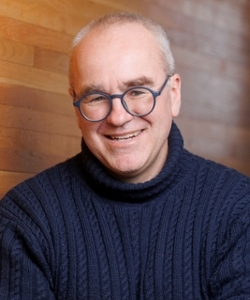
Looking Forward to the Past: Lessons for the Future of Medicare
The sixtieth anniversary of Medicare (Boan 2006) came and went last year with almost no fanfare. The lack of celebration is not difficult to understand. While surveys indicate Canadians value their public health care system, it is also clear the system is struggling, and many are skeptical that recent funding agreements between the federal government and the provinces hold out much hope for radical improvement.
By Marc-Andre Pigeon, Assistant Professor, JSGS, and Director and Strategic Research Fellow, CCSC; Haizhen Mou, JSGS Professor; Natalie Kallio, CCSC Professional Research AssociateDownload the JSGS Policy Brief
Download the Discussion Questions
The sixtieth anniversary of Medicare (Boan 2006)1 came and went last year with almost no fanfare. The lack of celebration is not difficult to understand. While surveys indicate Canadians value their public health care system, it is also clear the system is struggling, and many are skeptical that recent funding agreements between the federal government and the provinces hold out much hope for radical improvement.
The list of challenges with the Medicare system is long. Patients can’t find doctors (almost 1 in 5 Canadian adults) and those who do have doctors have a hard time getting in to see them (only 18% can get an appointment within a day or two) (Angus Reid Institute 2022)2. Doctors are burned out, leaving their practices with no one to replace them (Canadian Medical Association 2022)3. New physicians want to focus on patient care, not the business of health care (Mandryk 20224;Brcic et al. 20125; Lindsay Hedden et al. 20216; Mitra et al. 20217). In fact, a recent survey of Toronto doctors found 20% want out (Tara Kiran et al. 2022)8, raising the question of who will buy a business fewer and fewer doctors want to own? Meanwhile, hospitals continue to struggle with the ongoing challenges posed by a pandemic most seem to want to forget.
At the macro level, Canada is devoting a large share of its gross domestic product (GDP) to health care. In 2022, health care spending is expected to amount to 12.2% of GDP in Canada. In 2020, the latest year for which comparable data is available, Canada’s health spending as a percentage of GDP, at 12.9%, was less than the 18.8% in the United States but higher than the average (9.7%) of OECD countries (Canadian Institute for Health Information 2022b). While Canada’s life expectancy at birth is higher than the US—81.7 years, as compared to 77—and other OECD countries, it still only ranks 16th overall (OECD 2021).
Time for a New Model?
While these challenges might appear intractable, there is a growing consensus that part of the solution to Canada’s health care crisis involves a radical rethink to the way we deliver primary care. Primary care is a term used to describe the care people receive outside of hospitals when they visit a doctor, consult a nurse practitioner, or seek the advice of other health-care providers (WHO 2023a)9. For the most part, Canada’s primary care model is, and has been, built around doctor-owned businesses—often referred to as ‘medical practices'—that generate revenue based on a fee-for-service (FFS) basis (CIHI 2022a).10 This means doctors get paid on the type and number of patient visits and billable services they provide—and those per service fees need to pay for not only the doctor’s income but everything needed to run their practice (e.g., staffing, facilities, administration). In this model, doctors play three roles: businesspeople, healthcare decision-makers, and gatekeepers who shape and control everything from what services are provided (and not) to access to drugs and referrals to specialist services.
In 2020-21, 70% of clinical payments to physicians were fee-forservice payments (CIHI 2022a)11. Many argue FFS incentivizes quantity over quality (Mitchell 2017)12 of care and is unsuited to primary care (Glauser 2019)13. As modern health care becomes increasingly complex, the “soloist” private practice model of physicians is under pressure. For instance, from late 2019 to September 2022, Alberta physicians faced off against the government over government cost control and physician payment formulas (Alberta Medical Association (AMA) 201914; Bennett 202115). Overwhelmed by increasing complexity and workload, physicians—particularly younger physicians—have become more open to changes to care delivery models (Mitra et al. 2021)16. Against this backdrop, starting in 2000, the First Ministers in Canada promised to transform primary health care by promoting team-based care and integrating physicians into multi-disciplinary primary care teams (Suter et al. 2017)17.
Since the early 2000s, the provinces have all implemented primary care centers where doctors, while still playing a vital role, work as part of a team rather than as sole proprietors whose word is final (Hutchison et al. 2011)18. These reforms have been coupled with an increasing use of alternative payment methods such as capitation—supporting doctors and clinics based on the number of patients served rather than services provided—and blended payments that combine capitation and fee-for-service funding approaches
(OECD 2016)19. Early positive results include increased affiliation of patients with a habitual source of care and improved patient and provider experience (Levesque et al. 2015)20. However, due to the incremental nature of the reforms, there is no concrete evidence that these models have made transformative changes to patient outcomes, resulted in system-level cost savings, or led to adoption of appropriate organization and governance structures that could lock in and improve on these outcomes.
In the literature, Levesque et al. (2015) reviewed primary care reforms in Nova Scotia, Quebec, Ontario, Manitoba, and British Columbia between 2000 and 2010. Suter et al. (2017) compared key policies on team-based primary health care in three western provinces (British Columbia, Alberta, and Saskatchewan). Mitchell et al. (2012) summarized the values and principles behind effective team-based primary care delivery. These studies concluded common barriers to the implementation of team-based care include:
- Incompatibility of the fee-for-service payment method with team-based care
- Absence of meaningful patient voice in extant team-based care models
- Lack of clarity about the boundary between the scope of practice of health professionals
- The absence of integration of team-based care centers into the broader health and social care systems
As this brief survey suggests of research to-date, most of the existing research on team-based care regards primary care clinics as physician-centered businesses and focus on the effects of various physician payment methods on service quantity and quality (e.g.,Somé et al. 2020)21. Little attention is paid to the fact that health care is a co-production process. Co-production occurs when consumers and producers are both engaged in the development of a service or product (Parks et al. 1981)22. We hypothesize that optimal health outcomes can only be achieved when there is a meaningful collaborative partnership between patients, physicians, and other service providers (Turakhia and Combs 2017)23 .This is especially true as patient cases become more complex, with patients, particularly those of lower socioeconomic status, often needing mental health and substance use services, housing, and many other social services. Although the recent patient-centered care movement has allowed patients to assert an advisory role in health care, patients still tend to be viewed as recipients of services, not decision makers.
To overcome these barriers and unlock the benefits of team-based care, we think our primary care system needs a significant, not incremental, makeover. This means breaking decisively with fee-for-service and identifying a model that puts patients at the center of health decision-making and integrates health care with social services—and collect evidence of the results this produces.
The Co-operative Health Care Model
These may appear to be radical ideas but in fact, they can be traced back to the dawn of Medicare in 1962 and the resulting strike by Saskatchewan doctors worried about “socialized medicine” (Badgley and Wolfe 1967)24. Faced with the prospect of losing access to their doctors, almost 15,000 families representing 50,000 people formed 34 community clinic associations, raising more than $325,000 (almost $3M today) in less than a year (Smith 2010)25 for health-care clinics where patients would own and govern based on democratic co-operative principles (International Cooperative Alliance 2022)26. In short order, the patient-run clinics set about recruiting doctors from out-of-province, initially Great Britain (which already had a public health care system) and later Asia (Rands 1994)27.
The clinics adopted a philosophy of care that rejected many of the tenets of conventional medicine, which Stan Rands, a clinic organizer, described as focused on “physiological and biochemical causes of disease” and dependence on “equipment and tests for the diagnosis and treatment of illness” (1994)—and, thus, “ill-equipped to deal with the human and social manifestations of illness or disease.”
Based on this philosophy, the co-operative clinics implemented what were, at the time, radical measures. Instead of being paid on a fee-for-service basis, doctors were paid salaries. Instead of sole practitioner businesses, doctors worked as part of a team deeply engaged and responsive to their communities because the clinics were run by patients. Instead of treating symptoms, these team treated patients holistically, probing the physical and social factors (Maté and Maté 2022)28—now known as social determinants of health (WHO 2023b)29—that impact health outcomes. They were also early adopters of health promotion: instead of sending patients home with no further contact until the next visit, the clinics published and distributed a newsletter (the Saskatoon Community Clinic’s was aptly titled Focus: Social and Preventative Medicine) to educate patients about important health manners—e.g., anxiety, diabetes, nutrition, etc.—while also reminding patients of their agency in the governance of the clinic.
Despite strengthening the government’s hand in reaching a settlement with the striking doctors, the province never embraced the co-operative clinic model. Instead, the clinics spent years struggling to be understood by policymakers who, following concessions to appease the striking doctors’ objections, implemented a system favouring fee-for-service, doctor-led Medicare. This—and the medical association’s open hostility towards the clinics and obstruction of their doctors (Badgley and Wolfe 196730, 103; Gruending 1974, 10)31 —led many of the cooperative clinics to fold shortly after Medicare was introduced; by 1966, there were only eight and today, only four remain—large clinics in Prince Albert, Saskatoon, and Regina and one smaller rural clinic operating in Wynyard. Outside of Saskatchewan, the cooperative clinic footprint is small, with most provinces having only one or two at most. Even the Commission on the Future of Health Care in Canada, led by former Saskatchewan NDP premier Roy Romanow (2002), ignored the sector’s efforts to put their model on the agenda.
Away from the spotlight, the remaining co-operative clinics went about living their philosophy. They hired social workers, brought in physiotherapists, set up pharmacies, purchased x-ray devices for their members, offered in-house minor surgeries, performed house calls, operated forerunners to modern-day telehealth, and set up shop in places like Saskatoon’s west side—one of the poorest, most Indigenous urban areas in Canada—where private clinics were reluctant to go.
Along the way, the available evidence suggests they have generated consistently positive health outcomes for their patients and cost savings to the system relative to other forms of primary care (Angus and Manga 199032; Leviten-Reid 200933; Smith 201034; Saskatchewan Ministry of Health 198335; McPhee 197336). A detailed 1983 study found, for example, that the total cost to the health care system was 13% lower for community clinic patients in Prince Albert and 17% lower for patients in Saskatoon compared with private-practice patients in these communities. A more recent study of two clinics in neighbouring Alberta (HQCA 2019)37 that utilize a similar model of care but without a co-operative structure also found cost savings from community-based care. Benefitting from a rich data set and modern computer power, they report the practice models of these two clinics realized health system savings of $4.3 million and $7.2 million, respectively, in 2016-2017.
Gathering the Evidence: Testing the Co-op Clinic Model
If the co-operative clinic model has such obvious advantages, why has it not spread far and wide?
In one sense, it has. As noted earlier, every province has deployed some form of team-based care, a core feature of the co-operative clinic model. And yet, these efforts experience common barriers to effective teamwork, including fee-for-service incentives that are not aligned with a team-based approach, inadequate or non-existent integration of healthcare with other services, and—we believe, most importantly of all—the lack of meaningful patient voice. By contrast, co-operative community clinics seem to have figured out how to make the parts fit together—they have paid physicians as team members on salary instead of businesspeople working on a fee-for-service basis, they integrate health care into a broad range of programs and social services, and above all, they include patient voice in the core of their governance and service delivery.
Even if the spread of team-based care represents, in a sense, a successful propagation of a core feature of the co-operative clinic model, research also suggests there may be ongoing challenges for the co-operative clinics rooted in political, bureaucratic, and private (physician) interests (Smith 201038; MacKay 200739) that can be traced back to the doctors’ strike (Badgley and Wolfe 196740; Tollefson 196441). That said, there no longer appears to be organized resistance from doctors towards the co-operative clinics or towards clinic doctors (in the early days, they were denied hospital privileges and more – see Smith 2010). In fact, recent studies and evidence suggests that young doctors are increasingly interested in working as employees or staff rather than as businesspeople (Mitra et al. 202142; Brcic et al. 201243; Hedden et al. 2021)44, a reality that makes the co-operative clinic model attractive as a workplace.
While doctors may be less opposed to the co-operative clinic model and its salary-based model than they once were, the social, technological, and economic conditions that gave rise to the clinics have changed in a way that make it difficult for new cooperative clinics to emerge. In the 1960s, citizen mobilization of the kind that led to the formation of the clinics was commonplace in Saskatchewan, with its vigorous agriculture, credit union, and other co-operatives supported by the first-of-its kind provincial government agency called the Department of Co-operation and Co-operative Development (Argue 1992)45. As the SCC’s early newsletter shows, the co-operative sector played an important role in supporting citizen mobilization for the clinics by offering banking services, organizational capacity, and labour for construction. While the co-operative sector remains an important part of the province’s economy, its influence is diminished relative to the early days of the clinic, when the Saskatchewan Wheat Pool dominated the rural and economic landscape and credit unions and co-operative grocery stores were regularly coming into being. Alongside this change, awareness of the co-operative mode—and a willingness or cultural disposition to organize around self-provision rather than relying on markets or government—has also waned (CCSC 2016; Yu 2023)46. Meanwhile, the delivery of medical services has become increasingly technologically and bureaucratically complex, making it more difficult for citizens to mobilize around the formation of a new medical clinic without access to significant resources and supports.
That said, we believe the absence of recent and compelling empirical evidence may also be holding the model back, at least insofar as government willingness to incentivize expansion. As noted earlier, while there is some (but not much) research on team-based care, the empirical research on co-operative health clinics is, at best, forty years old. And while government agencies have access to thick data sets and powerful modern computing tools, there are still major challenges finding the money and time to do the work to assess the strengths of the co-operative health care model. But there is also a potentially more serious challenge with updating the empirical evidence, and that is interpretation: co-operative clinics—with their unfamiliar organizational model and deep member and community engagement—do not easily “fit” in the box of modern health care and easy empiricism. All too often, their contributions are hard-to-measure and go unnoticed, even by the experts who have access to the data.
And yet, we know evidence-based research will tend to find a more receptive audience, and higher likelihood of being acted upon, when existing policy paradigms struggle to explain and adapt to crisis situations (Hall 1993)47 like the one currently afflicting the public health care system, or when policy windows suddenly open through the confluence of problems, ideas, and politics (Kingdon 1995)48 like the one created by the COVID-19 pandemic. With that in mind, we are working on gathering the data and conducting the interviews that will help us test the effectiveness of the co-operative clinic model in terms of health and cost outcomes. Our goal is to better inform policymakers and address what is widely perceived as a gap in understanding of the co-operative health care model.
Conclusion
History suggests the co-operative community clinic model has the potential to improve the experience, health outcomes, and wellbeing of patients while reducing service provider stress and controlling government cost. While it is too early to say, conclusively, that the co-operative clinic model is superior to existing community-based team-based care models, some of our early data gathering—in the form of interviews and archival material—suggests the co-operative model holds considerable promise, especially as discontent over the broader health care system—and access to services intensifies.
While team-based community health clinics that take much from the co-operative clinic model are established in almost every province, particularly Ontario, there are also signs that the philosophy of patient-led care may be gaining ground. In 2017, for example, Ontario’s Mattawa First Nation opened the country’s first Indigenous-run co-operative clinic (“Matawa Health Co-Operative” 2023)49. Elsewhere, there are indications that citizens may be tired of waiting for policymakers to act and physicians to set up shop. For instance, residents of the Saanich Peninsula, on the southeast coast of Vancouver Island, raised money to open two medical clinics and recruit doctors who could take over from physicians at or near retirement. As Dale Henley, the co-chair of the non-profit that owns and operates the clinics told the Globe and Mail, “I think we’ve got to do a little more ourselves. We can’t just keep looking at governments all the time, because they’re not that good at it” (Howlett 2022)50.
As we look back on the 60 years of Medicare, and contemplate its many challenges, it may be time for communities to heed Mr. Henley’s call and, once again, voice their desire in words and action for access to the kind of holistic care pioneered by the co-operative clinics. With the right evidence, maybe this time policymakers will listen. With the right evidence, maybe this time policymakers will listen.
Marc-André Pigeon

Marc-André Pigeon is an Assistant Professor in the Johnson Shoyama Graduate School of Public Policy, University of Saskatchewan campus, and the Director of the Canadian Centre for the Study of Co-operatives. He holds a PhD in Mass Communications from Carleton University and has worked in a number of economics and policy-related positions, most recently as assistant vice-president of public policy at the Canadian Credit Union Association. He has also served as interim-vice president of government relations at CCUA, as a special advisor and senior project leader at the federal Department of Finance, and as lead analyst on several federal Parliamentary committees including the House of Commons Standing Committee on Finance, the Standing Committee on Public Accounts, the Standing Committee on Banking, Trade and Commerce, and the Standing Committee on Agriculture and Forestry. Dr. Pigeon also worked as an economic researcher at the Levy Economics Institute of Bard College and started his career as a financial journalist at Bloomberg Business News.
Haizhen Mou

Haizhen Mou is a Professor in the Johnson Shoyama Graduate School of Public Policy. Her primary research interests include fiscal governance, government budget management, fiscal federalism, and health care financing and expenditure, often from a political economy perspective. She received two SSHRC grants and several other awards.
Natalie Kallio

Natalie Kallio is a Professional Research Associate at the Canadian Centre for the Study of Co-operatives at the University of Saskatchewan. She holds an MA in Media Studies from Concordia University as well as Bachelor degrees in Education (OISE-UT) and English (USask). On campus, she helped build USask’s Learning Communities program and managed multidisciplinary, community-engaged research at the Saskatchewan Population Health and Evaluation Unit (SPHERU). In the decade between, she helmed harm reduction and supervised consumption programs in Saskatoon and Toronto, advising on policy change and working on dozens of advocacy and research teams and projects, locally and internationally. She also brings experience coordinating communications in the arts and cultural sector and serving as a board member at AKA and Fuse Magazine. She is also a longstanding volunteer supporting EGADZ Saskatoon Downtown Youth Centre’s “by youth-for youth” initiatives.
Endnotes
1 Boan, John A. 2006. “Medicare.” In The Encyclopedia of Saskatchewan. Canadian Plains Research Centre, University of Regina. https://esask.uregina.ca/entry/medicare.jsp
2 Angus Reid Institute. 2022. “Doc Deficits: Half of Canadians Either Can’t Find a Doctor or Can’t Get a Timely Appointment with the One They Have,” September 8, 2022. https://angusreid.org/canadahealth-
care-family-doctors-shortage/
3 Canadian Medical Association. 2022. “Critical Family Physician Shortage Must Be Addressed: CMA,” May 9, 2022. https://www.cma.ca/news-releases-and-statements/critical-family-physician-shortage-must-be-addressed-cma.
4 Mandryk, Murray. 2022. “Column: Sask. Family Doctor Shortage Requires New Approach.” Saskatoon StarPhoenix, October 15, 2022. https://thestarphoenix.com/opinion/columnists/murray-mandryk-sask-family-doctor-shortage-requires-new-approach/wcm/fcc52f2e-16df-4f34-84b1-8459a8552d40
5 Brcic, V, MJ McGregor, J Kaczorowski, and S Dharamsi. 2012. “Practiceand Payment Preferences of Newly Practising Family Physicians in British Columbia.” Can Fam Physician 58 (5): 275–81. https://www.ncbi.nlm.nih.gov/pmc/articles/PMC3352814/.
6 Lindsay Hedden, Setareh Banihosseini, Nardia Strydom, and Rita McCracken. 2021. “Family Physician Perspectives on Primary Care Reform Priorities: A Cross-Sectional Survey.” CMAJ Open 9 (2): E466.
https://doi.org/10.9778/cmajo.20200102.
7 Mitra, Goldis, Agnes Grudniewicz, M. Ruth Lavergne, Renee Fernandez, and Ian Scott. 2021. “Alternative Payment Models: A Path Forward.” Canadian Family Physician 67 (11): 805–7. https://doi.org/10.46747/cfp.6711805.
8 Tara Kiran, Ri Wang, Curtis Handford, Nadine Laraya, Azza Eissa, Pauline Pariser, Rebecca Brown, and Cheryl Pedersen. 2022. “Family Physician Practice Patterns during COVID-19 and Future Intentions.”
Canadian Family Physician 68 (11): 836. https://doi.org/10.46747/cfp.6811836
9 WHO. 2023a. “Primary Care.” World Health Organization. 2023. https://www.who.int/teams/integrated-health-services/clinicalservices- and-systems/primarycare#:~:text=Primary%20care%20is%20a%20model,have%20equal%20access%20to%20services.
10 Canadian Institute for Health Information. 2022a. “Health Workforce in Canada: In Focus (Including Nurses and Physicians).” Canadian Institute for Health Information. https://www.cihi.ca/en/health-workforce-in-canada-in-focus-including-nurses-and-physicians
11 Canadian Institute for Health Information. 2022a. “Health Workforce in Canada: In Focus (Including Nurses and Physicians).” Canadian Institute for Health Information. https://www.cihi.ca/en/health-workforce-in-canada-in-focus-including-nurses-and-physicians
12 Mitchell, Andrew. 2017. “Fee-for-Service: An Ethical Conflict.” Impact Ethics. https://impactethics.ca/2017/02/22/fee-for-service-an-ethicalconflict/#:~:text=When%20Canadian%20provinces%20instituted%20universal,patients%20into%20bits%20of%20piecework
13 Glauser, Wendy. 2019. “Why the Future of Health Care Is Salaried.” CMAJ News, November 28, 2019. https://cmajnews.com/2019/11/28/fee-forservice-1095819/
14 Alberta Medical Association (AMA). 2019. “Government Proposed Initiatives on Physician Compensation.” https://www.albertadoctors.org/services/physicians/our-agreements/insured-services-consultation/A_Plan_for_AMAs_Response_to_the_Insured.pdf.
15 Bennett, Dean. 2021. “Alberta Health Minister Says 2020 Changes to Doctor Billing Wrong, Won’t Be Repeated.” CTV News Edmonton, March 31, 2021. https://edmonton.ctvnews.ca/alberta-health-minister-says-2020-changes-to-doctor-billing-wrong-won-t-be-repeated-1.5359194.
16 Mitra, Goldis, Agnes Grudniewicz, M. Ruth Lavergne, Renee Fernandez, and Ian Scott. 2021. “Alternative Payment Models: A Path Forward.” Canadian Family Physician 67 (11): 805–7. https://doi.org/10.46747/cfp.6711805
17 Suter, Esther, Sara Mallinson, Renee Misfeldt, Omenaa Boakye, Louise Nasmith, and Sabrina T. Wong. 2017. “Advancing Team-Based Primary Health Care: A Comparative Analysis of Policies in Western Canada.” BMC Health Services Research 17 (1): 1–9.
18 Hutchison, Brian, Jean-Frédéric Levesque, Erin Strumpf, and Natalie Coyle. 2011. “Primary Health Care in Canada: Systems in Motion.” The Milbank Quarterly 89 (2): 256–88.
19 OECD. 2016. “Better Ways to Pay for Health Care.” Focus On. OECD. https://www.oecd.org/els/health-systems/better-ways-to-pay-for-healthcare-9789264258211-en.htm
20 Levesque, Jean-Frédéric, Jeannie L. Haggerty, William Hogg, Frederick Burge, Sabrina T. Wong, Alan Katz, Dominique Grimard, Jan-Willem Weenink, and Raynald Pineault. 2015. “Barriers and Facilitators for Primary Care Reform in Canada: Results from a Deliberative Synthesis across Five Provinces.” Healthcare Policy 11 (2): 44.
21 Somé, Nibene H., Rose Anne Devlin, Nirav Mehta, Gregory S. Zaric, and Sisira Sarma. 2020. “Stirring the Pot: Switching from Blended Fee-for-Service to Blended Capitation Models of Physician Remuneration.” Health Economics 29 (11): 1435–55.
22 Parks, R.B., P.C. Baker, L. Kiser, R. Oakerson, E. Ostrom, V. Ostrom, S.L. Percy, M.B. Vandivort, G.P. Whitaker, and R. Wilson. 1981. “Consumers as Co-Producers of Public Services: Some Economic and Institutional Considerations.” Policy Studies Journal 9: 1001–11. https://doi.org/10.1111/j.1541-0072.1981.tb01208.x.
23 Turakhia, Puja, and Brandon Combs. 2017. “Using Principles of Co-Production to Improve Patient Care and Enhance Value.” AMA Journal of Ethics 19 (11): 1125–31.
24 Badgley, Robin F., and Samuel Wolfe. 1967. Doctors’ Strike: Medical Care and Conflict in Saskatchewan. Toronto: T. H. Best Printing Co. Ltd.
25 Smith, Rochelle Elizabeth. 2010. “The Relationship between Saskatchewan’s Co-Operative Community Clinics and the Government of Saskatchewan: Toward a New Understanding.” https://harvest.usask.ca/handle/10388/etd-04122010-091353.
26 International Cooperative Alliance (ICA). 2022. “Cooperative Identity, Values & Principles.” ICA. 2022. https://www.ica.coop/en/cooperatives/cooperative-identity.
27 Rands, Stan. 1994. Privilege and Policy: A History of Community Clinics in Saskatchewan. Community Health Cooperative Federation.
28 Maté, Gabor, and Daniel Maté. 2022. The Myth of Normal : Trauma, Illness and Healing in a Toxic Culture. Toronto: Knopf Canada.
29 WHO 2023b. “Social Determinants of Health.” World Health Organization. 2023. https://www.who.int/health-topics/social-determinants-ofhealth#tab=tab_1.
30 Badgley, Robin F., and Samuel Wolfe. 1967. Doctors’ Strike: Medical Care and Conflict in Saskatche-wan. Toronto: T. H. Best Printing Co. Ltd.
31 Gruending, Dennis. 1974. “The First 10 Years.” Saskatoon: Community Health Services Association.
32 Angus, Douglas E., and Pram Manga. 1990. “Co-Op/Consumer Sponsored Health Care Delivery Effectiveness.” Canadian Co-operative Association.
33 Leviten-Reid, Catherine. 2009. “Conference Summary: The Role of Co-Operatives in Health Care.” Canadian Centre for the Study of Co-operatives.
34 Smith, Rochelle Elizabeth. 2010. “The Relationship between Saskatchewan’s Co-Operative Community Clinics and the Government of Saskatchewan: Toward a New Understanding.” https://harvest.usask.ca/handle/10388/etd-04122010-091353.36
35 Saskatchewan Ministry of Health. 1983. “Community Clinic Study.” Saskatchewan: Policy Research Branch.
36 McPhee, J.L. 1973. “Community Health Association Clinics: An Evaluation of the Hospital Utilization of Community Health Clinic Association.” Research and Planning Branch, Saskatchewan Department of Public Health.
37 Health Quality Council of Alberta. 2019. “A Case Study Evaluation: Crowfoot Village Family Practice and the Taber Clinic.” Health Quality Council of Alberta.
38 Smith, Rochelle Elizabeth. 2010. “The Relationship between Saskatchewan’s Co-Operative Community Clinics and the Government of Saskatchewan : Toward a New Understanding.” https://harvest.usask.ca/handle/10388/etd-04122010-091353.
39 MacKay, Lee. 2007. “Health Cooperatives in BC: The Unmet Potential.” British Columbia Medical Journal 49 (3): 128–42. https://bcmj.org/mds-be/health-cooperatives-bc-unmet-potential.
40 Badgley, Robin F., and Samuel Wolfe. 1967. Doctors’ Strike: Medical Care and Conflict in Saskatche-wan. Toronto: T. H. Best Printing Co. Ltd.
41 Tollefson, E.A. 1964. Bitter Medicine: The Saskatchewan Medicare Feud. Saskatoon: Modern Press.
42 Mitra, Goldis, Agnes Grudniewicz, M. Ruth Lavergne, Renee Fernandez, and Ian Scott. 2021. “Alternative Payment Models: A Path Forward.”
Canadian Family Physician 67 (11): 805–7. https://doi.org/10.46747/cfp.6711805.
43 Brcic, V, MJ McGregor, J Kaczorowski, and S Dharamsi. 2012. “Practice and Payment Preferences of Newly Practising Family Physicians in British Columbia.” Can Fam Physician 58 (5): 275–81. https://www.ncbi.nlm.nih.gov/pmc/articles/PMC3352814/.
44 Lindsay Hedden, Setareh Banihosseini, Nardia Strydom, and Rita McCracken. 2021. “Family Physician Perspectives on Primary Care Reform Priorities: A Cross-Sectional Survey.” CMAJ Open 9 (2): E466. https://doi.org/10.9778/cmajo.20200102.
45 Argue, Gregory H. 1992. “The Department of Co-Operation and Co-Operative Development, 1944 to 1987.” Masters of Arts, Regina: University of Regina. http://hdl.handle.net/10294/12484.
46 Yu, Stan. 2023. “Top Co-Op Issues 2022.” Saskatoon: Canadian Centre for the Study of Co-operatives. https://usaskstudies.coop/documents/pdfs/ccsc_top-co-op-issues-2022.pdf.
47 Hall, Peter A. 1993. “Policy Paradigms, Social Learning, and the State: The Case of Economic Policymaking in Britain.” Comparative Politics 25 (3): 275–96. https://doi.org/10.2307/422246.
48 Kingdon, John W. 1995. Agendas, Alternatives, and Public Policies. 2nd ed. New York: Longman.
49 “Matawa Health Co-Operative.” 2023. Matawa First Nations. 2023. http://www.matawa.on.ca/corporations/matawa-health-co-operative/.
50 Howlett, Karen. 2022. “How a Small Community on Vancouver Island Responded to a Looming Exodus of Family Doctors.” The Globe and Mail, December 2, 2022. https://www.theglobeandmail.com/canada/article-how-a-small-community-on-vancouver-island-responded-to-alooming/.


